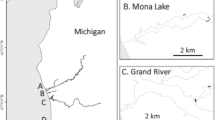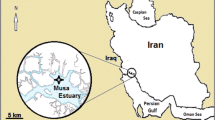Abstract
Concentrations of total mercury (T-Hg) and methylmercury (MeHg) in a wetland food chain were determined at Majuan Island of the Sanjiang Plain in China. Four tissues (muscle, liver, kidney and brain) of three waterbird species (great cormorant, grey heron and great egret), muscle tissues of fish (grass carp, crucian carp and longnose gudgeon), insects (predacious diving beetle), aquatic plants (ditch reed) and soil were analyzed. The mean concentrations of T-Hg were 0.392 ± 0.237 mg/kg for tissues of all juveniles, 1.999 ± 2.053 mg/kg for great cormorant adults, and 0.029 ± 0.019 mg/kg for fish muscle, respectively. While the relative contents of T-Hg of insects, plants and sediments were 0.012 ± 0.002, 0.006 ± 0.001 and 0.020 ± 0.002 mg/kg, respectively. Bioaccumulation of Hg along the wetland food chain may be able to show the current situation of Hg contamination in remote regions of East Asia.

Similar content being viewed by others
References
Anjos MR, Machado NG, Silva MEP et al (2016) Bioaccumulation of methylmercury in fish tissue from the Roosevelt River, s outhwestern Amazon basin. Rev Ambiente Agua 11(3):508–518
Binkowski LJ, Przystupinska A, Wojtas W (2015) Levels oft otalm ercury int issues ofm allardd rakes fromi ndustrializedw etlandsa rea. Bull Environ Contam Toxicol 96(2):173–178
Bose-O’Reilly S, Drasch G, Beinhoff C et al (2010) Health assessment of artisanal gold miners in Indonesia. Sci Total Environ 408(4):713–725
Brant HA, Jagoe CH, Snodgrass JW et al (2002) Potential risk to wood storks (Mycteria americana) from mercury in Carolina Bay fish. Environ Pollut 120:405–413
Burger J, Jehl JR, Gochfeld M (2013) Selenium: mercury molar ratio in eared grebes (Podiceps nigricollis) as a possible biomarker of exposure. Ecol Ind 34:60–68
Chetelat J, Amyot M, Arp P et al (2015) Mercury in freshwater ecosystems of the Canadian Arctic: recent advances on its cycling and fate. Sci Total Environ 509:41–66
Cheung K, Leung H, Wong M (2008) Metal concentrations of common freshwater and marine fish from the Pearl River Delta, South China. Arch Environ Contam Toxicol 54(4):705–715
Cleckner LB, Garrison PJ, Hurley JP et al (1998) Trophic transfer of methyl mercury in the northern Florida Everglades. Biogeochem 40(2–3):347–361
Connors P, Anderlini V, Risebromgh R et al (1975) Investigations of heavy metals in common tern populations. Can Field Nat 89:157–162
De-Moreno JEA, Gerpe MS, Moreno VJ et al (1997) Heavy metals in Antarctic organisms. Polar Biol 17(2):131–140
Diop M, Amara R (2016) Mercury concentrations in the coastal marine food web along the Senegalese coast. Enviro nSci Pollut Res 23:11975–11984
Falkowska L, Reindl AR, Szumilo E et al (2013) Mercury and chlorinated pesticides on the highest level of the food web as exemplified by herring from the southern Baltic and African penguins from the zoo. Water Air Soil Pollut 224:1–15
Fournier F, Karasov WH, Kenow KP et al (2002) The oral bioavailability and toxicokinetics of methylmercury in common loon (Gavia immer) chicks. Comp Biochem Physio Part A 133:703–714
Hinck JE, Schmitt CJ, Echols KR et al (2006) Environmental contaminants in fish and their associated risk to piscivorous wildlife in the Yukon River Basin, Alaska. Arch Environ Contam Toxicol 51(4):661–672
Honda K, Min BY, Tatsukawa R (1986) Distribution of heavy metals and their age-related changes in the eastern great white egret, Egretta alba modesta, in Korea. Arch Environ Contam Toxicol 15(2):185–197
Houserova P, Hedbavny J, Matejicek D et al (2005) Determination of total mercury in muscle, intestines, liver and kidney tissues of cormorant (Phalacrocorax carbo), great crested grebe (Podiceps cristatus) and Eurasian buzzard (Buteo buteo). Vet Med Czech 50:61–68
Houserova P, Kuban V, Kracmar S et al (2007) Total mercury and mercury species in birds and fish in an aquatic ecosystem in the Czech Republic. Environ Pollut 145(1):185–194
Hutton M (1981) Accumulation of heavy metals and selenium in three seabird species from the United Kingdom. Environ Pollut Series A Ecol Bio 26(2):129–145
Kabata-Pendias A (2010) Trace elements of group 12. In: Trace elements in soils and plants. CRC Press, Florida, pp 304–314
Krabbenhoft DP, Benoit JM, Babiarz CL et al (1995) Mercury cycling in the Allequash Creek watershed, northern Wisconsin. In: Mercury as a global pollutant. Springer Netherlands, Berlin, pp 425–433
Lewis S, Furness R (1991) Mercury accumulation and excretion in laboratory reared black-headed gull Larus ridibundus chicks. Arch Environ Contam Toxicol 21(2):316–320
Liu R, Wang QC, Lu XG et al (2002) Mercury in the peat bog ecosystem in Xiaoxing′an Mountain in China. Chinese J. Environ Sci 23(4):102–106
Meng ZQ (2006) Discussion on some essential concepts of ecotoxicology and environmental toxicology. Asian J Ecotoxicol 1(2):97–104
Paterson MJ, Rudd JWM, Louis VST (1998) Increase of total and methylmercury in zooplankton following flooding of peatland reservoir. Environ Sci Technol 32(24):3868–3874
Ruan L, Zhang Y, Zhao D et al (2003) Egretta garzetta as a bioindicator of environmental pollution in Tai Lake region. Chin J Ying Yong Sheng Tai Xue Bao 14(2):263–268
Ruelas-Inzunza J, Hernandez-Osuna J, Paez-Osuna F (2009) Organic and total mercury in muscle tissue of five aquatic birds with different feeding habits from the SE Gulf of California, Mexico. Chemosphere 76(3):415–418
Ruus A, Overjordet IB, Braaten HFV et al (2015) Methylmercury biomagnification in an Arctic pelagic food web. Environ Toxicol Chem 34(11):2636–2643
Saeki K, Okabe Y, Kim EY et al (2000) Mercury and cadmium in common cormorants (Phalacrocorax carbo). Environ Pollut 108(2):249–255
Scheuhammer AM, Wong AHK, Bond D (1998) Mercury and selenium accumulation in common loons (Gavia immer) and common mergansers (Mergus merganser) from eastern Canada. Environ Toxicol Chem 17(2):197–201
Sepulveda MS, Williams JGE, Frederick PC et al (1999) Effects of mercury on health and first-year survival of free-ranging great egrets (Ardea albus) from southern Florida. Arch Environ Contam Toxicol 37:369–376
Squadrone S, Brizio P, Stella C et al (2016) Presence of trace metals in aquaculture marine ecosystems of the northwestern Mediterranean Sea (Italy). Environ Pollut 215:77–83
Sunderland EM, Gobas FAPC, Heyes A et al (2004) Speciation and bioavailability of mercury in well-mixed estuarine sediments. Mar Chem 90(4):91–105
Wan Q, Feng XB, Zheng W et al (2008) Seasonal variation of total gaseous mercury in Changbai Mountain area. Chin J Huan Jing Ke Xue 29(2):296–299
Wang QC, Liu RH, Lu XG et al (2002) Progress of study on the mercury process in the wetland environment. Adv Earth Sci 17(6):881–885
Zhou L, Li J, Yin H et al (2005) Enrichment characteristics of heavy metals in heron eggs. Chin J Appl Ecol 16(10):1932–1937
Zillioux EJ, Porcella DB, Benoit JM (1993) Mercury cycling and effects in freshwater wetland ecosystems. Environ Toxicol Chem 12(12):2245–2264
Acknowledgements
This study was supported by National Natural Science Foundation of China (31400471, 41471081) and the Fundamental Research Funds for the Central Universities (2572014EA07-02).
Author information
Authors and Affiliations
Corresponding author
Rights and permissions
About this article
Cite this article
Zhilong, M., Qiang, W., Zhongsheng, Z. et al. Mercury Distribution Along the Food Chain of a Wetland Ecosystem at Sanjiang Plain, Northeast China. Bull Environ Contam Toxicol 98, 162–166 (2017). https://doi.org/10.1007/s00128-016-2005-2
Received:
Accepted:
Published:
Issue Date:
DOI: https://doi.org/10.1007/s00128-016-2005-2




